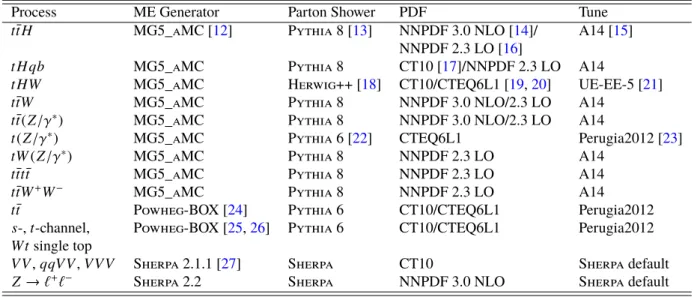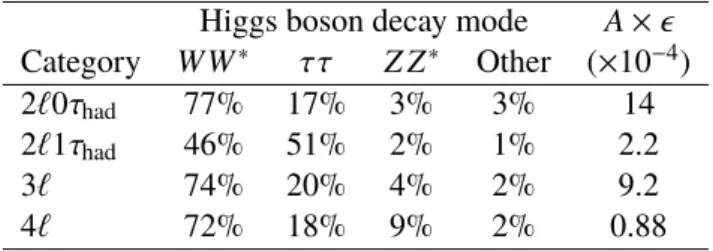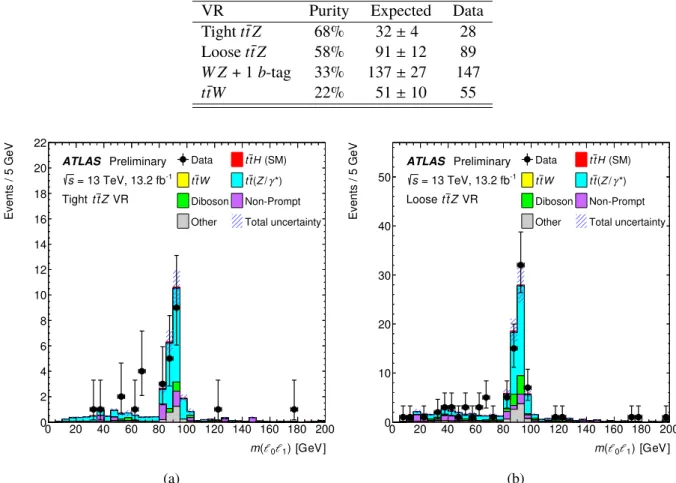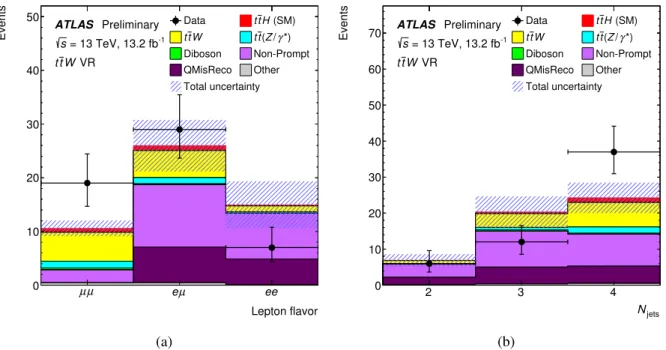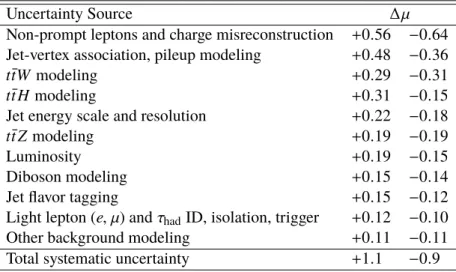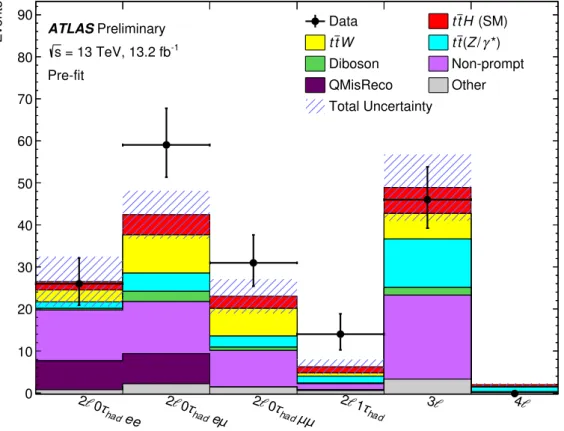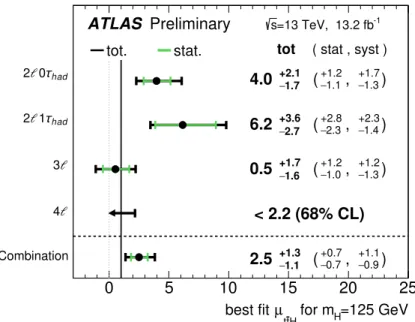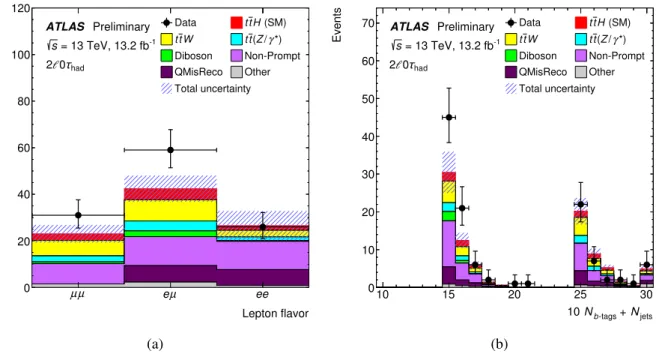ATLAS-CONF-2016-058 08August2016
ATLAS NOTE
ATLAS-CONF-2016-058
August 3, 2016
Search for the Associated Production of a Higgs Boson and a Top Quark Pair in Multilepton Final States with the ATLAS Detector
The ATLAS Collaboration
Abstract
The Yukawa coupling of the Higgs boson to the top quark is a key parameter of the Standard Model, and can be constrained using the associated production processpp →tt H¯ + X. A search for this process using final states with multiple leptons, primarily targeting the decays H →W W∗andH→ττ, has been performed using 13.2 fb−1of data recorded by the ATLAS detector in 2015 and 2016 at a center of mass energy
√s =13 TeV. The best-fit value of the ratio of observed and Standard Model cross sections is 2.5± 0.7 (stat)+1−0..19 (syst), and an upper limit on this ratio of 4.9 (2.3 expected) is found at 95% confidence level.
© 2016 CERN for the benefit of the ATLAS Collaboration.
1 Introduction
The Yukawa coupling of the Higgs boson to the top quark is a key parameter of the Standard Model (SM).
It can be determined from the ratio of the top quark mass and Higgs field vacuum expectation value, from the cross section ofgg→Hproduction through a top quark loop, or from the cross section of the process gg/qq →t¯t H, which is a tree-level process at lowest order in perturbation theory. Comparison of these measurements has the potential to identify and disambiguate new physics effects that can modify thet¯t H production cross section relative to the SM expectation.
The ATLAS and CMS collaborations have searched for production oftt H¯ inppcollisions at the Large Hadron Collider (LHC) using data collected during LHC Run 1 at a center of mass energy
√sof 7 and 8 TeV, with analyses sensitive toH →W W∗,ττ,bb¯, andγγdecays [1–5]. The combination of ATLAS and CMS Run 1 results yields a best fit of the ratio of observed and SM cross sections,µtt H¯ = σ/σSM, of 2.3+0−0..76. The excess over the SM expectation µtt H¯ =1 is driven primarily by multileptonic final states sensitive toH →W W∗andττ[6]. Improvement on this measurement requires the addition of more data.
The cross section fort¯t H production in the SM rises by a factor of 3.9 as the center of mass energy is changed from 8 to 13 TeV [7,8].
This note reports preliminary results of a search fortt H¯ production using 13.2 fb−1of data collected with the ATLAS detector at
√s=13 TeV during 2015 and 2016. The search uses four final states distinguished by the number and flavor of leptons: two same-charge light leptons (eorµ) and no hadronically-decaying τ lepton candidates (2`0τhad); two same-charge light leptons and one hadronically-decaying τ lepton candidate (2`1τhad); three light leptons (3`); and four light leptons (4`). These signatures are primarily sensitive toH →W W∗(with subsequent decay to`ν`νor`νj j) andH →ττdecays, and are effective in suppressingt¯tbackgrounds. Backgrounds are estimated with a combination of simulation and data-driven techniques, and a global fit to the yields in all final states is used to extract the best estimate for thet¯t H production rate.
2 ATLAS detector
The ATLAS experiment [9] at the LHC is a multi-purpose particle detector with a forward-backward sym- metric cylindrical geometry and a near 4πcoverage in solid angle.1It consists of an inner tracking detector surrounded by a thin superconducting solenoid providing a 2 T axial magnetic field, electromagnetic and hadron calorimeters, and a muon spectrometer. The inner tracking detector covers the pseudorapidity range|η|< 2.5. It consists of silicon pixel, silicon micro-strip, and transition radiation tracking detectors.
Lead/liquid-argon (LAr) sampling calorimeters provide electromagnetic (EM) energy measurements with high granularity and longitudinal segmentation. A hadron (steel/scintillator-tile) calorimeter covers the central pseudorapidity range (|η| < 1.7). The end-cap and forward regions are instrumented with LAr calorimeters for both EM and hadronic energy measurements up to |η| = 4.9. The muon spectrometer surrounds the calorimeters and is based on three large air-core toroid superconducting magnets with eight coils each. It includes a system of precision tracking chambers and fast detectors for triggering. A
1ATLAS uses a right-handed coordinate system with its origin at the nominal interaction point (IP) in the center of the detector and thez-axis along the beam pipe. The x-axis points from the IP to the center of the LHC ring, and the y-axis points upwards. Cylindrical coordinates(r, φ) are used in the transverse plane, φbeing the azimuthal angle around the z-axis.
The pseudorapidity is defined in terms of the polar angleθasη =−ln tan(θ/2). Angular distance is measured in units of
∆R≡
q(∆η)2+(∆φ)2.
Table 1: Configurations used for event generation of signal and background processes. If only one parton distribution function (PDF) is shown, the same one is used for both the matrix element (ME) and parton shower generators; if two are shown, the first is used for the matrix element calculation and the second for the parton shower. “V” refers to production of an electroweak boson (WorZ/γ∗). “Tune” refers to the underlying-event tune of the parton shower generator. “MG5_aMC” refers to MadGraph5_aMC@NLO 2.2.1; “Pythia 6” refers to version 6.427; “Pythia 8” refers to version 8.2; “Herwig++” refers to version 2.7. Samples using Pythia 6 and Pythia 8 have heavy flavor hadron decays modeled by EvtGen 1.2.0 [10]. All samples include leading-logarithm photon emission, either modeled by the parton shower generator or by PHOTOS [11].
Process ME Generator Parton Shower PDF Tune
tt H¯ MG5_aMC [12] Pythia 8 [13] NNPDF 3.0 NLO [14]/ A14 [15]
NNPDF 2.3 LO [16]
t H qb MG5_aMC Pythia 8 CT10 [17]/NNPDF 2.3 LO A14
t HW MG5_aMC Herwig++ [18] CT10/CTEQ6L1 [19,20] UE-EE-5 [21]
ttW¯ MG5_aMC Pythia 8 NNPDF 3.0 NLO/2.3 LO A14
tt¯(Z/γ∗) MG5_aMC Pythia 8 NNPDF 3.0 NLO/2.3 LO A14
t(Z/γ∗) MG5_aMC Pythia 6 [22] CTEQ6L1 Perugia2012 [23]
tW(Z/γ∗) MG5_aMC Pythia 8 NNPDF 2.3 LO A14
ttt¯t¯ MG5_aMC Pythia 8 NNPDF 2.3 LO A14
ttW¯ +W− MG5_aMC Pythia 8 NNPDF 2.3 LO A14
tt¯ Powheg-BOX [24] Pythia 6 CT10/CTEQ6L1 Perugia2012
s-,t-channel, Powheg-BOX [25,26] Pythia 6 CT10/CTEQ6L1 Perugia2012 W tsingle top
V V,qqV V,V V V Sherpa 2.1.1 [27] Sherpa CT10 Sherpa default
Z→`+`− Sherpa 2.2 Sherpa NNPDF 3.0 NLO Sherpa default
two-level trigger system is used to select events. The first-level trigger is implemented in hardware and uses a subset of the detector information to reduce the accepted rate to a design maximum of 100 kHz.
This is followed by a software-based trigger with a sustained average accepted event rate of 1 kHz.
3 Monte Carlo Event Generation
Event generator programs and configurations used for simulating the signal and background processes are shown in Table1. Detailed descriptions of the generator configurations may be found in Refs. [28–31].
In all cases a Higgs boson mass of 125 GeV is assumed. Generated events are passed through a full GEANT4 [32] simulation of the ATLAS detector. Additional minimum-bias ppinteractions (pileup) are modeled with the Pythia 8.1 generator with the MSTW2008LO parton distribution function (PDF) set [33] and the A2 tune [34], and are added to simulated events according to the luminosity profile of the recorded data.
Production oft¯t H,t¯tW, andtt Z¯ are simulated with a next-to-leading order (NLO) QCD matrix element computed by MadGraph5_aMC@NLO, matched to the Pythia 8 parton shower generator. In the case oft¯t Z, the inclusivett``¯ matrix element is computed, including off-shell Z andγ∗ contributions with m(``) > 5 GeV. For studies of systematic variations, samples with variations of the QCD factorization and renormalization scales by factors of 2 and 0.5 are used. Parton shower effects are studied by comparing the
nominalt¯t H sample with one with the same matrix element calculation but showered using Herwig++, and by comparing the nominalttV¯ samples with ones with variations in the A14 Pythia 8 tune.
The overall cross section fortt H¯ production, 507.1 fb, is computed at NLO in QCD and electroweak couplings [35–41] as compiled in Refs. [7, 8]. It has uncertainties of +5−9..8%2% from QCD renormaliza- tion/factorization scale choice and±3.6% from parton distribution function uncertainties (includingαs uncertainties).
The cross sections fort¯tV production, including the process pp →tt`¯ +`−+X over the full Z/γ∗ mass spectrum, are computed at NLO in QCD and electroweak couplings using the configuration of Refs. [12, 41]. These have QCD scale uncertainties≈ 12% and PDF+αs uncertainties of 3–4%. The total cross section used fortt`¯ +`−(withM(`+`−) > 5 GeV) is 123.7 fb, and fort¯tW±is 600.8 fb.
4 Object and Event Preselection
All analysis channels share a common trigger, jet, lepton and overall event preselection. These selections are detailed here; further channel-specific requirements are discussed in Section5.
Events are required to have been selected by single electron or muon triggers. For data recorded in 2015, these achieve maximal efficiency for an isolatede(µ) withpT >25 (21) GeV [42]; in 2016 these thresholds are 25 GeV for botheandµ. The trigger requirement is 94 to 99% efficient, depending on the final state, for events passing final signal region selections. The primary vertex in an event is chosen as the vertex with the highestP
p2
Tof associated tracks [43]. Events with significant noise in the calorimeters or data corruption are removed.
Electron candidates are reconstructed from energy clusters in the electromagnetic calorimeter that are associated with charged particle tracks reconstructed in the inner detector [44]. Only candidates with pT > 10 GeV are considered. They are required to satisfy |ηcluster| < 2.47. Candidates in the transition region between different electromagnetic calorimeter components, 1.37 < |ηcluster|< 1.52, are rejected. A multivariate likelihood discriminant combining shower shape and track information is used to distinguish real electrons from hadronic showers (fake electrons). Isolation variables are used to reduce the background from non-prompt electrons produced in hadron decays. Calorimetric isolation uses the sum of transverse energies of calorimeter clusters, excluding the electron candidate cluster itself, within a cone of∆R=0.2 of the electron candidate. Track isolation uses the sum of transverse momenta of tracks consistent with originating at the primary vertex, excluding the electron candidate track, within a cone of ∆R = min(0.2,10 GeV/pT(e)). For the object preselection, a loose electron discriminant working point is used, and an isolation selection tuned to be 99% efficient for prompt electrons in both calorimetric and tracking variables is chosen. To further reduce the non-prompt electron contribution, the track is required to be consistent with originating from the primary vertex; requirements are imposed on the transverse impact parameter significance and the longitudinal impact parameter, as shown in Table2.
Muon candidates are reconstructed by combining inner detector tracks with track segments or full tracks in the muon spectrometer [46]. In the region |η| < 0.1, where muon spectrometer coverage is reduced, muon candidates are also reconstructed from inner detector tracks matched to isolated energy deposits in the calorimeters consistent with the passage of a minimum-ionizing particle. Candidates are required to satisfypT > 10 GeV and|η| < 2.5. Calorimetric and track isolation are defined for muon candidates similarly as for electron candidates, except that the track isolation uses a larger cone size at low pT (∆R =min(0.3,10 GeV/pT(µ))). Calorimeter clusters within∆R= 0.1 of the muon candidate track are
Table 2: Tight and loose light lepton definitions. The lepton identification working points are documented in Refs. [44,45]. Selections for tight leptons are applied on top of the selections for loose leptons. “99% eff” refers to isolation working points designed to be 99% efficient for isolated leptons at allpT. (*) An additional “gradient”
isolation working point is defined with efficiency and fake/non-prompt lepton rejection intermediate between the loose and tight isolation selections.
Loose Tight
e µ e µ
Track isolation 99% eff. 99% eff. <0.06×pT(*) <0.06×pT(*) Calorimeter isolation 99% eff. 99% eff. <0.06×pT(*) 99% eff. (*)
Identification working point Loose Loose Tight Loose
Transverse impact parameter|d0|/σd0 <5 <3 <5 < 3 zimpact parameter|∆z0sinθ`| <0.5 mm <0.5 mm <0.5 mm < 0.5 mm
excluded from the calorimeter isolation computation to avoid counting the energy deposit of the muon.
The transverse impact parameter requirement for muon candidates is sightly tighter than for electrons, while the longitudinal impact parameter selection is the same.
Additional tighter isolation working points are applied on top of the loose selections in some cases to reduce fake and non-prompt lepton contributions. The tight working point, used in channels other than 4`, is shown in Table2; it is more restrictive than the 99% working point for lepton pT . 40 GeV and reduces fake and non-prompt lepton backgrounds at lowerpT. An additional working point, “gradient,”
is designed to give an increase in true isolated lepton efficiency from 87% atpT =10 GeV to 99% at 60 GeV, and is intermediate between the loose and tight definitions; it is used in the 4`channel to improve the signal efficiency.
Jets are reconstructed from calibrated topological clusters built from energy deposits in the calorimeters [47], using the anti-ktalgorithm with a radius parameterR=0.4 [48,49]. Jets with energy contributions likely arising from noise or detector effects are removed from consideration [50], and only jets satisfying pT >25 GeV and|η|< 2.5 are used in this analysis. For jets withpT < 60 GeV and|η| <2.4, a jet-track association algorithm is used to confirm that the jet originates from the selected primary vertex, in order to reject jets arising from pileup collisions [51]. The average efficiency of this association is 92% per jet.
Hadronically decaying τ lepton candidates (τhad) are reconstructed from clusters in the calorimeters and associated inner detector tracks [52]. The candidates are required to have either one or three associated tracks, with a total charge of±1. Candidates with pT > 25 GeV and |η| < 2.5, excluding the electromagnetic calorimeter transition region, are considered. A boosted decision tree discriminant using calorimeter and tracking-based variables is used to identifyτhad candidates and reject generic jet backgrounds. The chosen working point has an efficiency of 75% (59%) for one- (three-)prong τhad decays. Electrons which are reconstructed as one-prongτhad candidates are removed using a sliding cut on the electron likelihood ID variable; the rejection factor (inverse efficiency) for electrons is≈30–100 depending onη andpT.
Jets containingb-hadrons are identified (b-tagged) via a multivariate discriminant combining information from the impact parameters of displaced tracks with topological properties of secondary and tertiary decay vertices reconstructed within the jet. The working point used for this search corresponds to an average
efficiency of 70% forb-jets withpT > 20 GeV and |η| <2.5 int¯tevents. The expected rejection factors against light andc-jets are 380 and 12, respectively.
To avoid double counting objects and to remove leptons likely originating from hadron decays, ambiguities are resolved in the following order: anyτhadcandidate within∆R=0.2 of an electron or muon candidate is removed; if an electron candidate shares an inner-detector track with a muon, the electron candidate is kept if the muon candidate track has no extension to the muon spectrometer, otherwise the muon candidate is kept; electron candidates which share an inner-detector track with a muon candidate are removed; any jet within∆R=0.2 of an electron candidate is removed, then any electron candidate within∆R= 0.4 of a jet is removed; if a muon candidate and a jet lie within∆R=0.4 of each other, the muon is kept and the jet is removed if the jet has two or fewer tracks, else the muon is removed and the jet is kept; and any jet within∆R=0.2 of aτhadcandidate is considered only as aτhadcandidate in events with two light leptons.
This algorithm is applied to the preselected objects and all channel-specific further quality requirements on the leptons and jets start with the surviving candidates after this procedure.
Missing transverse momentum (Emiss
T ) is used to define certain additional selections for validation of background modeling. The missing transverse momentum vector is defined as minus the vector sum of the transverse momenta of all reconstructed and calibrated physics objects and remaining unclustered energy, the latter of which is estimated from low-pT tracks associated with the primary vertex but not assigned to a hard object [53]. The value ofEmiss
T for an event is the magnitude of this vector.
5 Channel Selections
Four final states, categorized by the number and flavor of leptons, are considered in this search: two same-charge light leptons with no hadronically-decayingτlepton candidate (2`0τhad), two same-charge light leptons with one hadronically-decaying τlepton candidate (2`1τhad), three light leptons (3`), and four light leptons (4`). The contribution to each of these final states from different Higgs boson decay modes, and the fraction of allt¯t H events captured by the event selections, is shown in Table3. Based on the number of lepton candidates after the preselection requirements, events are placed into at most one of these categories. Additional requirements beyond the preselection classification are applied depending on the final state. After all object selections, at least onee or µ candidate in the event is required to correspond to an object identified by the trigger system; this effectively requires one light lepton with pT >25 GeV (21 GeV for muons in 2015 data) in all channels.
5.1 2`0τhad Channel
The two light leptons are required to have the same charge. To reduce fake and non-prompt lepton back- grounds, tighter criteria are applied to the leptons than in the preselection, as detailed in Table2. Electrons are additionally required to satisfy|ηe| <1.37 to reduce the impact of electron charge misreconstruction through the processe± →γ(∗)e± →e∓e±e±occurring in detector material. Both leptons are required to have transverse momentumpT > 25 GeV. There must be no τhad candidates in the event. Events must have≥ 5 jets, of which≥1 must beb-tagged.
After this selection, the events are sorted into three subcategories based on the flavor of the leptons (ee, eµ, andµµ).
Table 3: Fraction of the expected t¯t H signal arising from different Higgs boson decay modes in each analysis category and acceptance times efficiency (A×) fortt H¯ signal in each category. The decays contributing to the
“other” column are dominantlyH→ µµandH→bb¯. Rows may not add to 100% due to rounding. The acceptance times efficiency includes Higgs boson and top quark branching fractions, detector acceptance, and reconstruction and selection efficiency, and is computed relative to inclusivett H¯ production.
Higgs boson decay mode A× Category W W∗ ττ Z Z∗ Other (×10−4)
2`0τhad 77% 17% 3% 3% 14
2`1τhad 46% 51% 2% 1% 2.2
3` 74% 20% 4% 2% 9.2
4` 72% 18% 9% 2% 0.88
5.2 2`1τhad Channel
The light leptons are required to pass the tight selections of Table2 and to have the same charge. No additional|η|requirement is placed on the electrons, but ine±e±events the invariant mass of the electrons must satisfy|m(e±e±)−91.2 GeV| >10 GeV to removeZ →e+e−events with a misreconstructed charge.
One lepton must have pT > 25 GeV, and the second must satisfy pT > 15 GeV. There must be exactly oneτhad candidate, of opposite charge to the light leptons. There must be≥4 jets, of which≥ 1 must be b-tagged.
5.3 3`Channel
The total charge of the three leptons in these events must be±1. The lepton of opposite charge to that of the other two is designated “lepton 0.” Of the two remaining leptons, the one with smallest∆R(`, `0) is designated “lepton 1” and the other is “lepton 2.” Backgrounds arising from the addition of a fake or non-prompt lepton to an opposite-charge dilepton event (such as dileptonict¯tproduction) will have that additional lepton be lepton 1 or 2, as it will be the same charge as a prompt lepton. Leptons 1 and 2 are required to pass the tight selections of Table2. Leptons 1 and 2 must additionally satisfy pT > 20 GeV. Lepton 0 is rarely fake or non-prompt, and so no additional requirements are imposed. To reject thett Z¯ background, all same-flavor`+`−pairs in the event must satisfy|m(`+`−)−91.2 GeV| >10 GeV.
To remove leptons from quarkonium decays, all same-flavor`+`−pairs must satisfym(`+`−) > 12 GeV.
To remove potential backgrounds with Z decays to``γ(∗) → ```0(`0), where one lepton has very low momentum and is not reconstructed, the three-lepton invariant mass must satisfy|m(3`)−91.2 GeV| >10 GeV. There must be either 3 jets in the event, of which at least two areb-tagged, or≥ 4 jets, of which at least one must beb-tagged. No requirement on additional τhad candidates is made, and any jets also reconstructed asτhadcandidates are treated only as jets.
5.4 4`Channel
The sum of the charges of the leptons in these events must be zero. All leptons must pass the gradient isolation selection. To rejectt¯t ZandZ Zbackground, all same-flavor`+`−pairs in the event must satisfy
|m(`+`−)−91.2 GeV| >10 GeV. To remove leptons from quarkonium decays, all same-flavor`+`−pairs
must satisfym(`+`−) >12 GeV. The four-lepton invariant mass must satisfy 100 GeV< m(4`) < 350 GeV to reduce contamination from Z → 4` at low mass and t¯t Z at high mass. To reduce contamination from other Higgs boson production processes and to ensure statistical independence from dedicated H → Z Z∗→4`measurements, a Higgs boson veto|m(4`)−125 GeV|> 5 GeV is applied. There must be at least two jets in the event, of which at least one must beb-tagged. No requirement onτhadcandidates is made, and any jets also reconstructed asτhad candidates are treated only as jets.
The signal region selections are summarized in the top rows of Table4.
6 Backgrounds
Backgrounds in the signal regions are categorized into those in which all the selected leptons are produced in decays of electroweak bosons or τ leptons (prompt leptons) and those in which at least one lepton arises from another source. In the latter case, the leptons arise from hadron decays or photon conversions (non-prompt), other interactions in detector material (charge misreconstruction or fake), or improper reconstruction of other particle species (fake).
6.1 Backgrounds with Prompt Leptons
These backgrounds are estimated using Monte Carlo (MC) simulation. In all final states,t¯tV production is the largest background with prompt leptons. Diboson production, in particularW Z, is subleading.
Rarer processes (t(Z/γ∗),tW(Z/γ∗),t¯ttt¯,t¯tW+W−) also contribute at a total level comparable to diboson production. For the purposes of this analysis associated production of a single top quark and a Higgs boson is considered as a background, and at the SM cross section contributes negligibly.
Systematic uncertainties on the acceptance for thettV¯ (V =WorZ/γ∗) backgrounds are derived using MC event simulation. Variations of hard process renormalization/factorization scale and PDF uncertainties are considered, as are uncertainties in the A14 parton shower tune for thet¯tV samples. Fort¯tW only, a comparison between NLO event generation and a leading-order merged calculation is done to test possible matrix element-parton shower matching effects.
The largest backgrounds with prompt leptons are studied in validation regions (VR) that are disjoint from the signal regions and enhance specific processes. These permit checks of the overall normalization and jet multiplicity dependence of specific backgrounds. The validation regions are summarized in the lower rows of Table4and a comparison of expected and observed yields is shown in Table5.
A validation region fortt Z¯ is defined by inverting the Z veto of the 3` signal region, and in addition tightening the jet selection by requiring≥ 4 jets of which≥ 2 areb-tagged. To gain additional events for comparison, a looser selection (≥4 jets of which at least one isb-tagged, or 3 jets of which at least 2 are b-tagged) is also used; the latter includes a larger fraction ofW Z events. Invariant mass plots for these VRs are shown in Figure1and show agreement between data and expectation in both regions.
The small number of events in the validation regions means it is not possible to constrain the cross section for production ofW Z or other diboson processes in association with c and b-quarks from data with high accuracy. To probe these processes, trilepton events with a Z candidate and a singleb-tagged jet were studied as a validation region. This VR is expected from simulation to contain similar numbers of mistaggedW Z + light quark/gluon jet,W Z+c, andW Z+bb¯ events, with the fraction ofW Z+bb¯
Table 4: Selections for the signal regions (SR) and validation regions (VR). The variableHT,jetsis the scalar sum of transverse momenta for the considered jets. Same-flavor, opposite-charge lepton pairs are referred to as SFOC pairs. Trigger-matched leptons correspond to an object reconstructed by the trigger, and must havepT >25 GeV (21 GeV for muons in 2015 data). In all regions at least one selected light lepton is required to be trigger-matched.
SR/VR Channel Selection criteria
SR 2`0τhad Two tight light leptons withpT >25, 25 GeV Sum of light lepton charges±2
Any electrons must have|ηe| <1.37 Zeroτhadcandidates
Njets ≥5 andNb−jets≥ 1
SR 2`1τhad Two tight light leptons, withpT >25, 15 GeV Sum of light lepton charges±2
Exactly oneτhadcandidate, of opposite charge to the light leptons
|m(ee)−91.2 GeV| >10 GeV foreeevents Njets ≥4 andNb−jets≥ 1
SR 3` Three light leptons; sum of light lepton charges±1
Two same-charge leptons must be tight and havepT > 20 GeV
m(`+`−) > 12 GeV and|m(`+`−)−91.2 GeV| >10 GeV for all SFOC pairs
|m(3`)−91.2 GeV| > 10 GeV
Njets ≥4 andNb−jets≥ 1, orNjets=3 andNb−jets≥ 2 SR 4` Four light leptons; sum of light lepton charges 0
All leptons pass “gradient” isolation selection
m(`+`−) > 12 GeV and|m(`+`−)−91.2 GeV| >10 GeV for all SFOC pairs 100 GeV< m(4`) <350 GeV and|m(4`)−125 GeV| >5 GeV
Njets ≥2 andNb−jets≥ 1 VR Tightt¯t Z 3`lepton selection
At least one`+`−pair with|m(`+`−)−91.2 GeV| <10 GeV Njets ≥4 andNb−jets≥ 2
VR Looset¯t Z 3`lepton selection
At least one`+`−pair with|m(`+`−)−91.2 GeV| <10 GeV Njets ≥4 andNb−jets≥ 1, orNjets=3 andNb−jets≥ 2 VR W Z+ 1b-tag 3`lepton selection
At least one`+`−pair with|m(`+`−)−91.2 GeV| <10 GeV Njets ≥1 andNb−jets=1
VR t¯tW 2`0τhad lepton selection 2≤ Njets ≤4 andNb−jets≥2
HT,jets>220 GeV foreeandeµevents Emiss
T >50 GeV and (m(ee) <75 orm(ee) >105 GeV) foreeevents
Table 5: Expected and observed event yields in validation regions (VR). The quoted uncertainties in the expectations include all systematic uncertainties. “Purity” indicates the fraction of events in the VR expected to arise from the targeted process (tt Z¯ for the first two VRs,W Zfor the third, andt¯tWfor the fourth).
VR Purity Expected Data
Tightt¯t Z 68% 32±4 28
Looset¯t Z 58% 91±12 89 W Z+ 1b-tag 33% 137±27 147
ttW¯ 22% 51±10 55
m(ℓ0ℓ1) [GeV]
0 20 40 60 80 100 120 140 160 180 200
Events / 5 GeV
0 2 4 6 8 10 12 14 16 18 20 22
ATLAS Preliminary = 13 TeV, 13.2 fb-1
s
VR Z t Tight t
Data ttH (SM) W
t
t tt(Z/γ*) Diboson Non-Prompt Other Total uncertainty
(a)
m(ℓ0ℓ1) [GeV]
0 20 40 60 80 100 120 140 160 180 200
Events / 5 GeV
0 10 20 30 40 50
ATLAS Preliminary = 13 TeV, 13.2 fb-1
s
VR Z t Loose t
Data ttH (SM) W
t
t tt(Z/γ*) Diboson Non-Prompt Other Total uncertainty
(b)
Figure 1: Invariant mass of leptons 0 and 1 for the a) tight and b) loosett Z¯ validation regions. The leptons are labeled in the same way as for the 3`signal region. Events away from theZpeak are those satisfying theZselection with leptons 0 and 2. Non-prompt lepton backgrounds are estimated using data as described in Section6.2.
increasing with jet multiplicity. The makeup of the signal regions is predicted to be similar to this VR at high jet multiplicity. The jet multiplicity in these events is modeled well as shown in Figure2. This agreement indicates that the heavy flavor versus light flavor content of these events is simulated reasonably well. A 50% uncertainty on the diboson background normalization is adopted, motivated by the available statistical constraints onW Z+candW Z+bb¯production from this validation region.
No high-purity, high-yield validation region fort¯tW production is available. A preliminary measurement ofttW¯ production with 13 TeV data at the LHC [54] finds a cross section consistent with the SM prediction with a total uncertainty of 56%, dominated by the limited event yield. Here, at¯tW validation region is defined using the 2`0τhad lepton selection and requiring between two and four jets of which at least two areb-tagged. Foreeandeµevents the total scalar sum of jet transverse momenta (HT,jets) must exceed 220 GeV; in addition foreeevents the dilepton invariant mass must not be in the range 75–105 GeV and the missing transverse energy Emiss
T must exceed 50 GeV. The results are shown in Figure 3; data are consistent with expectation.
Njets
1 2 3 4 5 6 7 8 9
Events
0 10 20 30 40 50 60
ATLAS Preliminary = 13 TeV, 13.2 fb-1
s
-tag VR + 1 b WZ
Data ttH (SM) W
t
t tt(Z/γ*) Diboson Non-Prompt Other Total uncertainty
Figure 2: Jet multiplicity in theW Z + 1 b-tag validation region. Non-prompt lepton backgrounds are estimated using data as described in Section6.2.
Lepton flavor µ
µ eµ ee
Events
0 10 20 30 40
50 ATLAS Preliminary = 13 TeV, 13.2 fb-1
s VR W t t
Data ttH (SM) W
t
t tt(Z/γ*) Diboson Non-Prompt QMisReco Other Total uncertainty
(a)
Njets
2 3 4
Events
0 10 20 30 40 50 60
70 ATLAS Preliminary = 13 TeV, 13.2 fb-1
s VR W t t
Data ttH (SM) W
t
t tt(Z/γ*) Diboson Non-Prompt QMisReco Other Total uncertainty
(b)
Figure 3: Lepton flavor composition (a) and number of jets (b) for events in thettW¯ validation region. Non-prompt lepton and charge misreconstruction backgrounds (indicated as “QMisReco”) are estimated using data as described in Section6.2.
6.2 Backgrounds with Non-Prompt Leptons and FakeτhadCandidates
Backgrounds involving non-prompt leptons and fake τhad candidates are estimated using data-driven methods. Monte Carlo studies indicate that, with the lepton identification requirements used, the fraction ofeandµcandidates in signal and validation regions that are not realeandµleptons is negligible. Monte Carlo simulation studies show that the dominant source of non-prompt leptons in all channels is decays of heavy flavor hadrons, primarily intt¯events. The background from conversion of high-pT photons is tested using dedicatedt¯tγ simulation and found to be negligible. The inclusivet¯t MC sample includes conversions due to photons emitted in initial- or final-state radiation using a leading-logarithm shower [11].
The 2`0τhad, 2`1τhad, 3`, and 4`final states have different estimation techniques for these backgrounds due to limitations of obtaining enough events in data control regions to estimate rates. In addition the trident process e± → γ(∗)e± → e∓e±e± can result in a high-pT electron with opposite charge to the original prompt electron (charge misreconstruction). A large fraction ofτhadcandidates are quark/gluon-initiated jets, and these are referred to as “fakeτhad.”
6.2.1 Charge misreconstruction
Charge misreconstruction affects the 2`0τhad categories with electrons and the 2`1τhad category when electrons are present (the impact on the µµ+0τhad, 3`, and 4` channels is negligible): an event with an opposite-charge light lepton pair is made to appear as a same-charge pair. The rates for charge misreconstruction are determined from data using dielectron events withm(ee) consistent with the Z mass, comparing the yields of opposite-charge and same-charge events. The charge misreconstruction rate is parametrized as a function of parent electronpT and|η| and simulation is used to extrapolate for electronpT > 130 GeV. The charge misreconstruction rates vary from 2×10−4 for low-pT electrons at small |η| to 10−2 for high-pT electrons with 1.1 < |η| < 1.37 (electrons at higher |η| are not used in the 2`0τhadchannel). For high-pTelectrons with|η| ∼ 2.47 (relevant for the 2`1τhadchannel) the charge misreconstruction rate reaches 10−1. The rates are verified by using them to estimate the yield of e±e± events compatible with the Z mass and associated with a b-jet. The prediction matches the observed data yield within a total uncertainty of 15%. The charge misreconstruction rates are applied to opposite- charge dilepton events that otherwise pass the same selections as the 2`0τhad subcategories to obtain the background estimate.
Charge misreconstruction for muons arises from improper reconstruction of the curvature of very highpT tracks, and is negligible in this analysis.
6.2.2 Non-prompt leptons in the 2`0τhadchannels
Backgrounds with non-prompt leptons in the 2`0τhadchannels are estimated by extrapolating from control regions dominated by such backgrounds into the signal region. Leptons which pass the loose but not tight selections are termed “anti-tight” leptons and are highly enriched in non-prompt leptons. The ratio of non-prompt leptons passing tight and anti-tight selections is measured from data, and gives transfer factors for non-prompt electrons and muons. These are then applied to events that pass signal region selections except for having one tight and one anti-tight lepton, giving an estimate of the yield of events with non-prompt leptons in the signal region.
